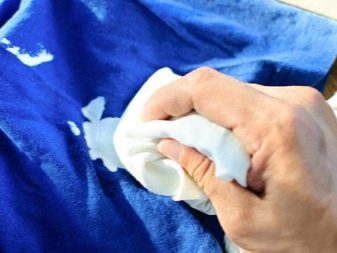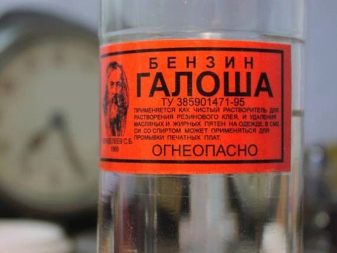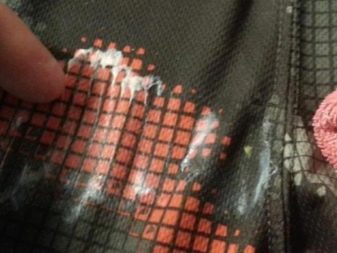How to remove the corrector from your clothes?

Stroke specks on clothes are a nuisance that affects both adults and children. Schoolchildren, students and office workers who use a clerical proofreader on an ongoing basis are especially affected. Fortunately, in almost any case, the stain can be removed from the fabric without even ruining it.

We study the composition
To get rid of the white spot, you need to start by studying the composition of the corrector, which is usually written on the bottle. It is not possible to determine it completely, since more often it is a secret of the company. There are certain chemical compounds that are present in any corrective composition, regardless of the manufacturer. These include calcium carbonate and titanium dioxide, as well as highly refined gasoline. However, the main criterion is the base, and its composition can always be found on the label.

There are several variations of the "putty":
- water based;
- alcohol-based;
- oil-based;
- on an emulsion basis.
In addition, there is a dry corrector, so do not panic and do not use the first product that comes to hand. Better first figure out what you are dealing with. The technique will be approximately the same, but the cleansers will be different.

Methods for removing different stains
After determining the composition of the corrector, select the appropriate method for removing the dirt. The sooner you start cleaning, the more effectively you will deal with the problem. The easiest to clean is the dry or water-based concealer, the hardest is the oil-based options.
Water proofreader - environmentally friendly, harmless to health, safe for children and people with allergies. It does not smell and copes well with paper of any quality, and if it dries, it can be diluted with plain water. Unfortunately, the water stroke dries for a rather long time - up to 1 minute and does not tolerate low temperatures.

An alcohol-based corrector dries quickly, can be kept even in frost, but, like any alcohol-containing device, it is quite dangerous. If used improperly, it can easily ignite, it also smells rather harsh, so you need to use it with special care. Often, such a corrector is sold with an alcohol-based solvent that can be used to reanimate a dried solution.
"Putty" on an emulsion or oil base combines the properties of the other two varieties. It is considered the most resistant, dries quickly and has high frost resistance. Separately, a dry corrector is distinguished - this is a dry composition in the form of a tape, which is located in a convenient reel. Using such a stroke, you do not need to wait long for it to dry, but with it you will not be able to correct errors and small size errors.


In addition, there are liquid and dry "putties". The former include correction fluids in a plastic bottle with a convenient brush, as well as pencils / pens filled with correction fluid. To dry - roller strokes, inside of which a tightly twisted tape with a densely applied dry composition is placed.
Water based
To wash off a water-based product, you need to carry out a few simple manipulations:
- first of all, dilute the laundry soap or washing powder in a basin with the coldest water possible (strokes of this type are afraid of low temperatures);
- soak clothes in liquid for 20-30 minutes;
- then wash the garment in the machine using a program suitable for the type of fabric.


As you can see, it is not difficult to remove the clerical putty. Even with black trousers, the stains will disappear completely. Besides, there is another way:
- wet a spot with ice water;
- then apply a few drops of lemon juice on it for 15-20 minutes;
- then machine wash the item.
Remember that stroke splatter will only be completely removed with pre-soak. Do not try to wipe off the "putty" - it will only be absorbed deeper into the fibers.


Alcoholic
The essence of eliminating such contamination is as follows: it must be soaked with the same that is at the base of the corrector. If you're trying to clean an alcohol-based touch from your jacket at home, wait until it dries completely before picking up an alcohol-based product. Then carefully try to scrape the paint off the clothes mechanically: with a mild abrasive nail file, an old toothbrush, or some obtuse-angled object.
Spread the garment out on a flat surface with a clean, non-dyeing cotton rag or a few paper towels under the wrong side. It is important that the lining does not fade. Wipe the rest of the stroke with soft surface movements with a cotton swab or a cloth soaked in ethyl or denatured alcohol, alcohol-based cologne or vodka. This action can be repeated twice. Complete the procedure with the usual procedure in the washing machine.


You can also quickly remove dirt, for example, from trousers, if you wash clothes in warm water, to which ammonia is added.
Do not forget to pre-treat the surface of the pants with an ammonia solution and place the cotton wool soaked in it for 10-15 minutes.
In some cases, nail polish remover will help. The dense material used to make jeans can be tried with refined gasoline available from the store. Soak a cotton swab, keep it on the spot for 2-3 minutes, and then send the item to the washing machine.


Oil
If you want to clean an oil-based or emulsion-based concealer, prepare a clean cloth, cotton wool and a solvent - kerosene, acetone, white spirit. The oil is difficult to clean, so you have to use chemicals. First, check the grout at the seams. If the fabrics do not lose color and do not deform, then you can start processing the contaminated surface.
Wet the area around the pollution with water - this way, the stain will not creep and retain its boundaries. Use a cotton swab to treat the stain remover twice, using a methodical motion, from the edges to the center. And the third time - from the wrong side. Do not rub the solvent into the material! Then machine wash the garment using liquid powder in combination with fabric softener. Remember to ventilate your clothes well.

If the solvent spoils the fabric, then it is better to contact a professional and take it to a dry cleaner. You can also try treating the surface with a solution of water and ammonia (2 to 1 ratio). There is a chance that ordinary dishwashing detergent will help as well - apply it to the wetted area, leave it for an hour, and then follow the usual algorithm.
Solvent-based corrector can be eliminated in the same way. The only difference is it is better to handle the stain from the wrong side. In addition, when faced with this type of "putty", soak clothes in warm water for half an hour, then add stain remover there and wash the item by hand. Then follow the above algorithm.

Dry
To wipe off dry concealer tape, do the same as for the water-based streak situation. Soak clothes in soapy water for 40 minutes, and then machine wash on a delicate cycle. The tape will quickly get wet and quickly come off the clothes, then it will remain to carry out minimal processing.
Brush the garment before washing, if desired. After the washing machine, there will be no trace of the corrector.


Additional Tips
It is recommended to adhere to some simple tips for high-quality cleaning of things from the corrector:
- do not even try to remove the concealer yourself from delicate fabrics such as silk, wool, satin, velvet (and other fluffy designs). In case of failure, you will simply lose your thing, so give up independent experiments;
- if the corrector is liquid, then first you need to absorb the excess with a dry or damp cloth, and then wait until it dries completely;
- it is better to soak clothes for 10-15 minutes in water at room temperature;
- do not rub the corrector until it is completely dry. So, on the contrary, you will "drive" the substance into the material deeper. In addition, the area of contamination will increase;
- try to process the fabric from the wrong side, especially if you are working with a solvent;
- at the end of the procedure, be sure to dry the item in a well-ventilated place;


- if the durability of the fabric is in doubt, then conduct a "test drive" on a hidden area, for example, seams, or on a fragment of similar material;
- the fresher the pollution, the easier it will be to deal with;
- When cleaning the corrector, try to avoid using high temperature water. Boiling water will only aggravate the situation - the corrector will “brew up”, so it will be almost impossible not to eliminate it;
- do not use bleaches and stain removers;
- remove small specks with cotton swabs, and not with discs or cloth rags;
- products that are used to "dilute" dried streaks can also be used to remove stains from clothing. Apply them according to the instructions. However, do not take risks with thin and delicate fabrics;
- pure acetone is used in cases of absolutely white things;
- the water for washing cannot be very hot, but it is better to set the speed of the "drum" high;


- in an emergency, when the stain needs to be removed immediately, and there is no solvent at hand, try to remove the "putty" with some colorless alcohol;
- to prevent trouble, henceforth give preference to ribbon stroke or water-based;
- it is not recommended to treat clothes with perfume or eau de toilette - they have a persistent odor that is difficult to get rid of. In addition, there is little alcohol in their composition, so the result will be weak;
- when working with solvents, observe fire safety regulations at all times. It is better to process clothes in the fresh air, or at least remember to ventilate the thing;
- gasoline is not suitable for synthetic clothing as it dissolves fibers;
- do not wash the item before dry cleaning.
Well, now we recommend watching a short video from which you will learn how to easily clean the corrector from clothes at home.








